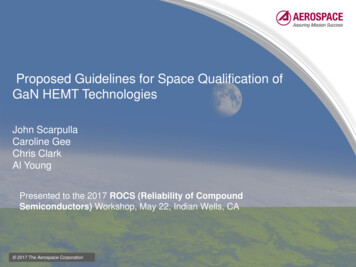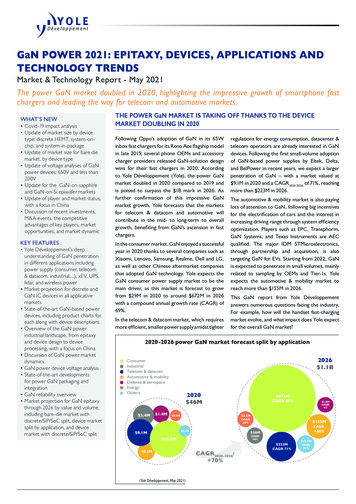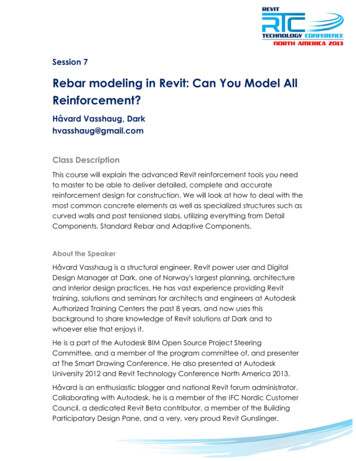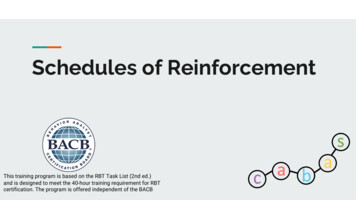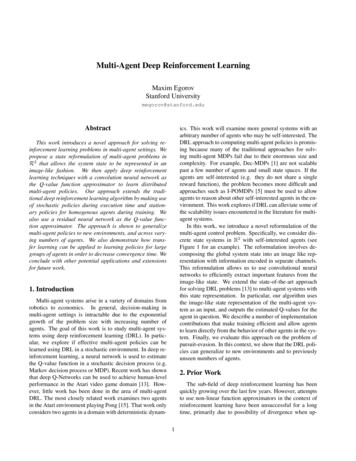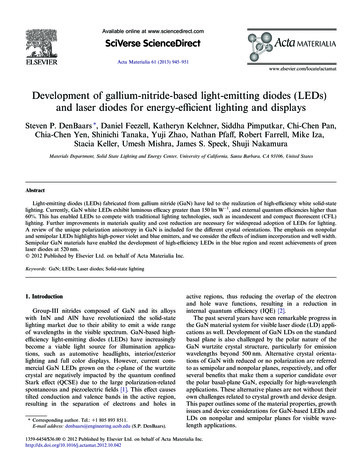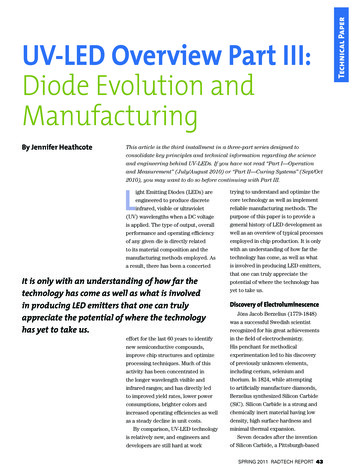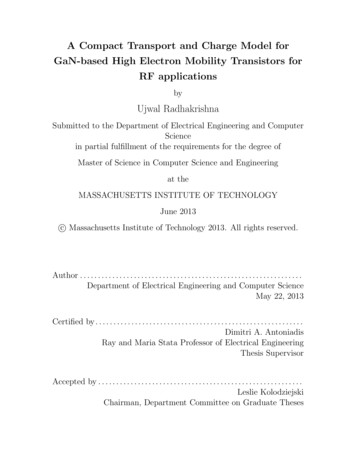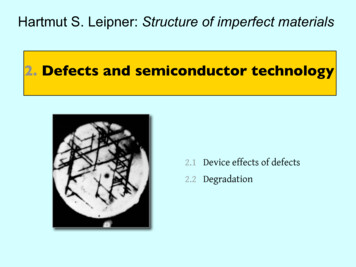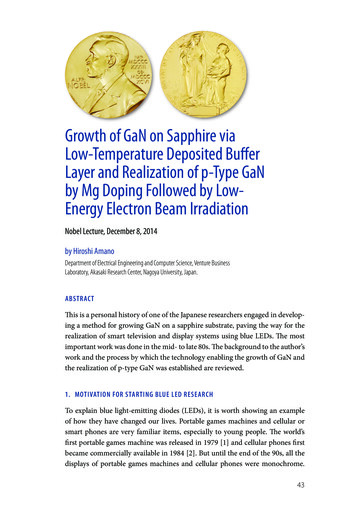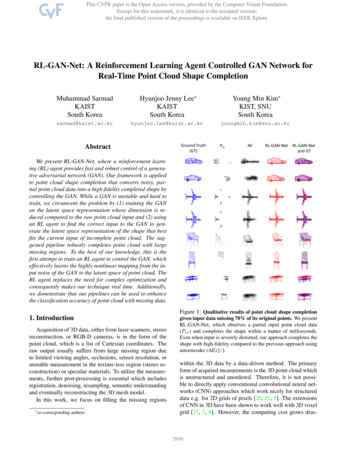
Transcription
RL-GAN-Net: A Reinforcement Learning Agent Controlled GAN Network forReal-Time Point Cloud Shape CompletionMuhammad SarmadKAISTSouth KoreaHyunjoo Jenny Lee KAISTSouth KoreaYoung Min Kim KIST, SNUSouth gmin.kim@snu.ac.krAbstractGround Truth(GT)PinAERL-GAN-Net RL-GAN-Netand GTWe present RL-GAN-Net, where a reinforcement learning (RL) agent provides fast and robust control of a generative adversarial network (GAN). Our framework is appliedto point cloud shape completion that converts noisy, partial point cloud data into a high-fidelity completed shape bycontrolling the GAN. While a GAN is unstable and hard totrain, we circumvent the problem by (1) training the GANon the latent space representation whose dimension is reduced compared to the raw point cloud input and (2) usingan RL agent to find the correct input to the GAN to generate the latent space representation of the shape that bestfits the current input of incomplete point cloud. The suggested pipeline robustly completes point cloud with largemissing regions. To the best of our knowledge, this is thefirst attempt to train an RL agent to control the GAN, whicheffectively learns the highly nonlinear mapping from the input noise of the GAN to the latent space of point cloud. TheRL agent replaces the need for complex optimization andconsequently makes our technique real time. Additionally,we demonstrate that our pipelines can be used to enhancethe classification accuracy of point cloud with missing data.Figure 1: Qualitative results of point cloud shape completion1. IntroductionAcquisition of 3D data, either from laser scanners, stereoreconstruction, or RGB-D cameras, is in the form of thepoint cloud, which is a list of Cartesian coordinates. Theraw output usually suffers from large missing region dueto limited viewing angles, occlusions, sensor resolution, orunstable measurement in the texture-less region (stereo reconstruction) or specular materials. To utilize the measurements, further post-processing is essential which includesregistration, denoising, resampling, semantic understandingand eventually reconstructing the 3D mesh model.In this work, we focus on filling the missing regions co-correspondingauthorsgiven input data missing 70% of its original points. We presentRL-GAN-Net, which observes a partial input point cloud data(Pin ) and completes the shape within a matter of milliseconds.Even when input is severely distorted, our approach completes theshape with high-fidelity compared to the previous approach usingautoencoder (AE) [1].within the 3D data by a data-driven method. The primaryform of acquired measurements is the 3D point cloud whichis unstructured and unordered. Therefore, it is not possible to directly apply conventional convolutional neural networks (CNN) approaches which work nicely for structureddata e.g. for 2D grids of pixels [20, 21, 5]. The extensionsof CNN in 3D have been shown to work well with 3D voxelgrid [37, 7, 8]. However, the computing cost grows dras-5898
Figure 2: The forward pass of our shape completion network. By observing an encoded partial point cloud, our RL-GAN-Net selectsan appropriate input for the latent GAN and generates a cleaned encoding for the shape. The synthesized latent representation is decodedto get the completed point cloud in real time. In our hybrid version, the discriminator finally selects the best shape.tically with voxel resolution due to the cubic nature of 3Dspace. Recently PointNet [33] has made it possible to directly process point cloud data despite its unstructured andpermutation invariant nature. This has opened new avenuesfor employing point cloud data, instead of voxels, to contemporary computer-vision applications, e.g. segmentation,classification and shape completion [1, 15, 34, 9, 10].In this paper, we propose our pipeline RL-GAN-Net asshown in Fig. 2. It is a reinforcement learning agent controlled GAN (generative adversarial network) based network which can predict complete point cloud from incomplete data. As a pre-processing step, we train an autoencoder (AE) to get the latent space representation of thepoint cloud and we further use this representation to traina GAN [1]. Our agent is then trained to take an ’action’by selecting an appropriate z vector for the generator of thepre-trained GAN to synthesize the latent space representation of the complete point cloud. Unlike the previous approaches which use back-propagation to find the correct zvector of the GAN [15, 40], our approach based on an RLagent is real time and also robust to large missing regions.However, for data with small missing regions, a simple AEcan reliably recover the original shape. Therefore, we usethe help of a pre-trained discriminator of GAN to decidethe winner between the decoded output of the GAN and theoutput of the AE. The final choice of completed shape preserves the global structure of the shape and is consistentwith the partial observation. A few results with 70% missing data are shown in Fig. 1.To the best of our knowledge, we are the first to introducethis unique combination of RL and GAN for solving thepoint cloud shape completion problem. We believe that theconcept of using an RL agent to control the GAN’s outputopens up new possibilities to overcome underlying instabilities of current deep architectures. This can also lead toemploying similar concept for problems that share the samefundamentals of shape completion e.g. image in-painting[40].Our key contributions are the following: We present a shape completion framework that is robust to low-availability of point cloud data without anyprior knowledge about visibility or noise characteristics. We suggest a real-time control of GAN to quickly generate desired output without optimization. Because ofthe real-time nature, we demonstrate that our pipelinecan pre-process the input for other point cloud processing pipelines, such as classification. We demonstrate the first attempt to use deep RL framework for the shape completion problem. In doing so,we demonstrate a unique RL problem formulation.2. Related WorksShape Completion and Deep Learning. 3D shape completion is a fundamental problem which is faced when processing 3D measurements of the real world. Regardless ofthe modality of the sensors (multi-view stereo, the structureof light sensors, RGB-D cameras, lidars, etc.), the outputpoint cloud exhibits large holes due to complex occlusions,limited field of view and unreliable measurements (becauseof material properties or texture-less regions). Early worksuse symmetry [38] or example shapes [32] to fill the missing regions. More recently databases of shapes has beenused to retrieve the shape that is the closest to the currentmeasurement [19, 22].Recently, deep learning has revolutionized the field ofcomputer vision due to the enhanced computational power,the availability of large datasets, and the introduction of efficient architectures, such as the CNN [5]. Deep learninghas demonstrated superior performance on many traditionalcomputer vision tasks such as classification [20, 21, 16] andsegmentation [24, 29]. Our 3D shape completion adapts thesuccessful techniques from the field of deep learning anduses data-driven methods to complete the missing parts.3D deep learning architecture largely depends on thechoice of the 3D data representation, namely volumetric5899
voxel grid, mesh, or point cloud. The extension of CNNin 3D works best with 3D voxel grids, which can be generated from point measurements with additional processing. Dai et al. [7] introduced a voxel-based shape completion framework which consists of a data-driven networkand an analytic 3D shape synthesis technique. However,voxel-based techniques are limited in resolution becausethe network complexity and required computations increasedrastically with the resolution. Recently, Dai et al. [8] extended this work to perform scene completion and semanticsegmentation using coarse-to-fine strategy and using subvolumes. There are also manifold-based deep learning approaches [28] to analyze various characteristics of completeshapes, but these lines of work depend on the topologicalstructure of the mesh. Such techniques are not compatiblewith point cloud.Point cloud is the raw output of many acquisition techniques. It is more efficient compared to the voxel-basedrepresentation, which is required to fully cover the entirevolume including large empty spaces. However, most ofthe successful deep learning architectures can not be deployed on point cloud data. Stutz et al. [37] introduced anetwork which consumes incomplete point cloud but theyuse a pre-trained decoder to get a voxelized representationof the complete shape. Direct point cloud processing hasbeen made possible recently due to the emergence of newarchitecture such as PointNet [33] and others [34, 9, 17].Achlioptas et al. [1] explored learning shape representation with auto-encoder. They also investigated the generation of 3D point clouds and their latent representationwith GANs. Even though their work performs a certainlevel of shape completion, their architecture is not designedfor shape completion tasks and suffers from considerabledegradation as the number of missing points at the input are increased. Gurumurthy et al. [15] have suggestedshape completion architecture which utilizes latent GANand auto-encoder. However, they use a time-consuming optimization step for each batch of input to select the best seedfor the GAN. While we also use latent GAN, our approachis different because we use a trained agent to find the GAN’sinput seed. In doing so, we complete shapes in a matter ofmilliseconds.GAN and RL. Recently, Goodfellow et al. [13] suggestedgenerative adversarial networks (GANs) which use a neuralnetwork (a discriminator) to train another neural network(a generator). The generator tries to fool the discriminator by synthesizing fake examples that resembles real data,whereas the discriminator tries to discriminate between thereal and the fake data. The two networks compete with eachother and eventually the generator learns the distribution ofthe real data.While GAN suggests a way to overcome the limitationof data-driven methods, at the same time, it is very hardto train and is susceptible to a local optimum. Many improvements have been suggested which range from changesin the architecture of generator and discriminator to modifications in the loss function and adoption of good trainingpractices [2, 41, 42, 14]. There are also practices to controlGAN by observing the condition as an additional input [26]or using back-propagation to minimize the loss between thedesired output and the generated output [40, 15].Our pipeline utilizes deep reinforcement learning (RL)to control the complex latent space of GAN. RL is a framework where a decision-making network, also called anagent, interacts with the environment by taking availableactions and collects rewards. RL agents in discrete actionspaces have been used to provide useful guides to computer vision problems such as to propose bounding box locations [3, 4] or seed points for segmentation [36] with deepQ-network (DQN) [27]. On the other hand, we train anactor-critic based network [23] learning the policy in continuous action space to control GAN for shape completion. Inour setup, the environment is the shape completion framework composed of various blocks such as AE and GAN,and the action is the input to the generator. The unknownbehavior of the complex network can be controlled with thedeep RL agent and we can generate completed shapes fromhighly occluded point cloud data.3. MethodsOur shape completion pipeline is composed of three fundamental building blocks, which are namely an autoencoder (AE), a latent-space generative adversarial network(l-GAN) and a reinforcement learning (RL) agent. Eachof the components is a deep neural network that has to betrained separately. We first train an AE and use the encodeddata to train l-GAN. The RL agent is trained in combinationwith a pre-trained AE and GAN.The forward pass of our method can be seen in Fig. 2.The encoder of the trained AE encodes the noisy and incomplete point cloud to a noisy global feature vector (GFV).Given this noisy GFV, our trained RL agent selects the correct seed for the l-GAN’s generator. The generator producesthe clean GFV which is finally passed through the decoderof AE to get the completed point cloud representation ofthe clean GFV. A discriminator observes the GFV of thegenerated shape and the one processed by AE and selectsthe more plausible shape. In the following subsections, weexplain the three fundamental building blocks of our approach, then describe the combined architecture.3.1. Autoencoder (AE)An AE creates a low-dimensional encoding of input databy training a network that reproduces the input. An AE iscomposed of an encoder and a decoder. The encoder con-5900
verts a complex input into an encoded representation, andthe decoder reverts the encoded version back to the originaldimension. We refer to the efficient intermediate representation as the GFV, which is obtained upon training an AE.The training of AE is performed with back-propagation reducing the distance between input and output point cloud,either with the Earth Movers distance (EMD) [35] or theChamfer distance [10, 1]. We use the Chamfer distance overEMD due to its efficiency which can be defined as follows:XX22min ka bk2 ,min ka bk2 dCH (P1 , P2 ) a P1b P2b P2a P1(1)where in Eq. (1) the P1 and P2 are the input and output pointcloud respectively.We first train a network similar to the one reported byAchlioptas et al. [1] on the ShapeNet point cloud dataset[39, 6]. Achlioptas et al. [1] also demonstrated that a trainedAE can be used for shape completion. The trained decodermaps GFV into a complete point cloud even when the inputGFV has been produced from an incomplete point cloud.But the performance degrades drastically as the percentageof the missing data in the input is increased (Fig. 1).3.2. l-GANGAN generates new yet realistic data by jointly training a pair of generator and discriminator [13]. WhileGAN demonstrated its success in image generation tasks[41, 14, 2], in practice, training a GAN tends to be unstableand suffer from mode collapse [25]. Achlioptas et al. [1]showed that training a GAN on GFV, or latent representation, leads to more stable training results compared to training on raw point clouds. Similarly, we also train a GAN onGFV, which has been converted from complete point clouddata using the encoder of trained AE, Sec. 3.1. The generator synthesizes a new GFV from a noise seed z, whichcan then be converted into a complete 3D point cloud usingthe decoder of AE. We refer to the network as l-GAN orlatent-GAN.Gurumurthy et al. [15] similarly utilized l-GAN for pointcloud shape completion. They formulated an optimizationframework to find the best input z to the generator to createGFV that best explains the incomplete point cloud at theinput. However, as the mapping between the raw points andthe GFV is highly non-linear, the optimization could not bewritten as a simple back-propagation. Rather, the energyterm is a combination of three loss terms. We list the lossesbelow, where Pin is the incomplete point cloud input, E andE 1 are the encoder and the decoder of AE, and G and Drepresent the generator and the discriminator of the l-GANrespectively. Chamfer loss: the Chamfer distance between the input partial pointcloud Pin and the generated, decodedpointcloud E 1 (G(z))LCH dCH (Pin , E 1 (G(z)))(2) GFV loss: l2 distance between the generated GFVG(z) and the GFV of the input pointcloud E(Pin )2LGF V kG(z) E(Pin )k2(3) Discriminator loss: the output of the discriminatorLD D(G(z))(4)Gurumurthy et al. [15] optimized the energy function defined as a weighted sum of the losses, and the weights gradually evolve with every iteration. However, we propose amore robust control of GAN using an RL framework, wherean RL agent quickly finds the z-input to the GAN by observing the combination of losses.3.3. Reinforcement Learning (RL)In a typical RL-based framework, an agent acts in anenvironment. Given an observation xt at each time step t,the agent performs an action at and receives a reward rt .The agent network learns a policy π which maps states tothe action with some probability. The environment can bemodeled as a Markov decision process, i.e., the current stateand action only depend on the previous state and action.The rewardPT at any given state is the discounted future rewardRt i t γ (i t) r(si , ai ). The final objective is to find apolicy which provides the maximum reward.We formulate the shape completion task in an RL framework as shown in Fig. 3. For our problem, the environmentis the combination of AE and l-GAN, and resulting lossesthat are calculated as intermediate results of various networks in addition to the discrepancy between the input andthe predicted shape. The observed state st is the initial noisyGFV encoded from the incomplete input point cloud. Weassume that the environment is Markov and fully observed;i.e., the recent most observation xt is enough to define thestate st . The agent takes an action at to pick the correct seedfor the z-space input of the generator. The synthesized GFVis then passed through the decoder to obtain the completedpoint cloud shape.One of the major tasks in training an RL agent is the correct formulation of the reward function. Depending on thequality of the action, the environment gives a reward r backto the agent. In RL-GAN-Net, the right decision equatesto the correct seed selection for the generator. We usethe combination of negated loss functions as a reward forshape completion task [15] (Sec. 3.2) that represent lossesin all of Cartesian coordinate (rCH LCH ), latent space(rGF V LGF V ), and in the view of the discriminator(rD LD ). The final reward term is given as follows:r wCH · rCH wGF V · rGF V wD · rD ,5901(5)
Figure 3: Training RL-GAN-Net for shape completion. OurRL framework utilizes AE (shown in green) and l-GAN (shown inblue). The RL agent and the environment are shaded in gray, andthe embedded reward, states, and action spaces are highlighted inred. The output is decoded and completed as shown at the bottom.Note that the decoder and decoded point cloud in the upper rightcorner is added for a comparison, and does not affect the training.By employing an RL agent, our pipeline is capable of real-timeshape completion.where wCH , wGF V , and wD are the corresponding weightsassigned to each loss function. We explain the selection ofweights in the supplementary material.Since the action space is continuous, we adopt deep deterministic policy gradient (DDPG) by Lillicrap et al. [23].In DDPG algorithm, a parameterized actor network µ(s θµ ) learns a particular policy and maps states to particular actions in a deterministic manner. The critic networkQ(s, a) uses the Bellman equation and provides a measureof the quality of action and the state. The actor networkis trained by finding the expected return of the gradient tothe cost J w.r.t the actor-network parameters, which is alsoknown as the policy gradient. It can be defined as below: θµ J(θ) Est ρβ [ α Q(s, a θQ ) s st ,a µ(st ) θµ µ(s θµ ) s st ]Algorithm 1 Training RL-GAN-NetAgent Input:State (st ): st GF Vn E(Pin ); Sample pointcloud Pinfrom dataset into the pre-trained encoder E to generatenoisy latent representation GF Vn .Reward (rt ): Calculated using Eq. (5)Agent Output:Action (at ): at zPass z-vector to the pre-trained generator G to form cleanlatent vector GF Vc G(z)Final Output:Pout E 1 (GF Vc ); Pass GF Vc into decoder E 1 togenerate output point cloud Pout .1: Initialize procedure Env with pre-trained generator G,discriminator D, encoder E and decoder E 12: Initialize policy π with DDPG, actor A, critic C, andreplay buffer R3: for tsteps maxsteps do4:Get Pin5:if tsteps 0 then6:Train A and C with R7:if tLastEvaluation fEvalF requency then8:Evaluate π9:GF Vn E(Pin )10:if tsteps tStartT ime then11:Random Action at12:if tsteps tStartT ime then13:Use at A GF Vn14:(st , at , rt , st 1 ) Env at15:Store transition (st , at , rt , st 1 ) in Rendfor16: procedure E NV (Pin ,at )17:Get State (st ) : GF Vn E(Pin )18:Implement Action : GF Vc G (at z)19:Calculate reward rt using Eq. (5)20:Obtain point cloud : Pout E 1 (GF Vc )(6)Before training the agent, we make sure that AE and GANare adequately pre-trained as they constitute the environment. The agent relies on them to select the correct action.The algorithm of the detailed training process is summarized in Algorithm 1.3.4. Hybrid RL-GAN-NetWith the vanilla implementation described above, thegenerated details of completed point cloud can sometimeshave limited semantic variations. When the portion of missing data is relatively small, the AE can often complete theshape that agrees better with the input point cloud. On theother hand, the performance of AE degrades significantlyas more data is missing, and our RL-agent can nonethelessfind the correct semantic shape. Based on this observation,we suggest a hybrid approach by using a discriminator asa switch that selects the best results out of the vanilla RLGAN-Net and AE. The final pipeline we used for the resultis shown in Fig. 2. Our hybrid approach can robustly complete the semantic shape in real time and at the same timepreserve local details.4. ExperimentsWe used PyTorch [31] and open source codes [12, 18,30, 11] for our implementation. All networks were trainedon a single Nvidia GTX Titan Xp graphics card. The details5902
Ground Truth(GT)PinAEratio (%)time (ms)RL-GAN-Net RL-GAN-Netand GT201.310401.293301.295501.266701.032Table 1: The average action time for the RL agent to produceclean GFV from observation of noisy GFV. Our approach can create the appropriate z-vector approximately in one millisecond.Figure 4: Qualitative results of point cloud shape completionmissing 20% of its original points. With relatively small missing data, AE sometimes performs better in completing shapes.Therefore, our hybrid RL-GAN-Net reliably selects the best output shape among the AE and the vanilla RL-GAN-Net.of network architectures are provided in the supplementarymaterials. For the experiments, we used the four categorieswith the most number of shapes among ShapeNetCore [6, 1]dataset, namely cars, airplanes, chairs, and desks. The total number of shapes sums to 26,829 for the four classes.All shapes are translated to be centered at the origin andscaled such that the diagonals of bounding boxes are of unitlength. The ground-truth point cloud data is generated byuniformly sampling 2048 points on each shape. The pointsare used to train the AE and generate clean GFV to trainthe l-GAN. The incomplete point cloud is generated by selecting a random seed from the complete point cloud andremoving points within a certain radius. The radius is controlled for each shape to obtain the desired amount of missing data. We generated incomplete point cloud missing 20,30, 40, 50 and 70% of the original data for test, and trainedour RL agent on the complete dataset.4.1. Shape Completion ResultsWe present the results using the two variations of ouralgorithm, the vanilla version and the hybrid approach asmentioned in Sec. 3. Since the area is relatively new, thereare not many previous works available performing shapecompletion in point cloud space. We compare our resultagainst the method using AE only [1].Fig. 5a shows the Chamfer distances of the completedshape compared against the ground-truth point cloud. Withpoint cloud input with 70% of its original points missing,the Chamfer distance compared to ground truth increase upto 16% of the diagonal of the shape, but the reconstructedshapes of AE, vanilla and hybrid RL-GAN-Net all show lessthan 9% of the distances.While the Chamfer distance is a widely used metric tocompare shapes, we noticed that it might not be the absolutemeasure of the performance. From Fig. 5a, we noticed thatthe input point cloud Pin was the best in terms of Chamfer distance for 20% missing data. However, from our visual inspection in Fig. 4, the completed shapes, while theymight not be exactly aligned in every detail, are semantically reasonable and does not exhibit any large holes thatare clearly visible in the input. For the examples with datamissing 70% of its original points in Fig. 1, it is obviousthat our approach is superior to AE, whose visual qualityfor completed shape severely degrades as the ratio of missing data increases. However, the Chamfer distance is almostthe same for AE and RL-GAN-Net. The observation canbe interpreted as the fact that 1) AE is specifically trainedto reduce the Chamfer loss, thus performs better in termsof the particular loss, while RL-GAN-Net jointly considersChamfer loss, latent space and discriminator losses, and 2)Pin has points that are exactly aligned with the GT, which,when averaged, compensates errors from missing regions.Nonetheless our hybrid approach correctly predicts thecategory of shapes and fills the missing points even witha large amount of missing data. In addition, the RLcontrolled forward pass takes only around a millisecondto complete, which is a huge advantage over previouswork [15] that requires back-propagation over a complexnetwork. They claim the running time of 324 seconds fora batch of 50 shapes. On the other hand, our approach isreal-time and easily used as a preprocessing step for various tasks, even at the scanning stage.Comparison with Dai et al. [7] While there is not muchprior work in point cloud space, we include the completionresults of Dai et al [7] which works in a different domain(voxel grid). To briefly describe, their approach used anencoder-decoder network in 323 voxel space followed by ananalytic patch-based completion in 1283 resolution. Theirresults of both resolutions are available as distance functionformat. We converted the distance function into a surface5903
(a) Chamfer distance to GT(b) Classification accuracy [33](c) Loss termsFigure 5: Performance analysis. We compare the two versions of our algorithms against the original input and the AE in terms of (a) theChamfer distance (the lower the better) and (b) the performance gain for shape classification (the higher the better). (c) We also analyzethe losses of RL-GAN-Net with different amount of missing data.representation using the MATLAB function isosurface asthey described, and uniformly sampled 2048 points to compare with our results. We present the qualitative visual comparison in Fig. 6. The results of encoder-decoder based network (referred as Voxel 323 in the figure) are smoother thanpoint clouds processed by AE as the volume accumulationcompensates for random noise. However, the approach islimited in resolution and washes out the local details. Evenafter the patch-based synthesis in 1283 resolution, the details they could recover are limited. On the other hand, ourapproach robustly preserves semantic symmetries and completes local details in challenging scenarios. It should benoted that we used only scanned point data but did not incorporate the additional mask information, which they utilized. More results are included in the supplementary material due to the limitation of space.4.2. Application into ClassificationAs an alternative measure to test the performances of thesemantic shape completion, we compared the classificationaccuracy of Pin and the shapes completed by AE and RLGAN-Net. This scenario also agrees with the main applications that we intended. That is, RL-GAN-Net can be used asa quick preprocessing of the captured real data before performing other tasks as the raw output of 3D measurementsare often partial, noisy data to be used as a direct input topoint cloud processing framework. We took the incomplete input and first processed through our shape completion pipeline. Then we analyzed the classification accuracyof PointNet [33] with the completed point cloud input andcompared against the results with incomplete input. Fig. 5bshows the improvement of classification accuracy. Clearly,our suggested pipeline reduces possible performance lossesof existing networks by completing the defects in the input.We also would like to add a note about the performanceof the vanilla RL-GAN-Net and the hybrid approach. Wenoticed that the main achievement of our RL agent is oftenlimited to finding the correct semantic categories in the latent space. The hybrid approach overcomes the limitationFigure 6: Performance Comparison. Comparison of RLGANNet vs Dai et al.[7] for their 323 and 1283 resolution results. Weconverted their distance function output to point cloud domain.It should be noted that they additionally have mask informationwhereas we operate directly on the scanned points only.by selecting the results of AE when the shape is more reasonable according to the trained discriminator. This agreeswith the fact that the hybrid approach is clearly better interms of Chamfer distance in Fig. 5a, but is comparablewith the vanilla approach in classification in Fig. 5b, wherethe task is finding the correct category. Fig. 7 shows someexamples of failure cases, where the suggested internal category does not exactly align with the observed shape.4.3. Reward Function AnalysisWe demonstrate the effects of the three different lossterms we used. Fig. 5c shows the change of loss values ofgenerated pointcloud with different amount of missing data.5904
Ground Truth(GT)PinAERL-GAN-Net RL-GAN-Netand GTPinAELCH onlyFigure 7: Failure cases. RL-GAN-Net can sometimes predict awrong category (top) or semantically similar but different shape ofthe category (bottom).Both Chamfer loss LCH and GFV loss LGF V increase for alarge amount of missing data. This is reasonable considering that we need to
duced compared to the raw point cloud input and (2) using an RL agent to find the correct input to the GAN to gen-erate the latent space representation of the shape that best fits the current input of incomplete point cloud. The sug-gested pipeline robustly completes point cloud with large missing regions. To the best of our knowledge, this .
